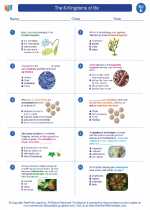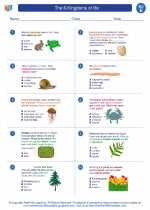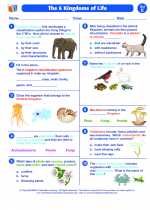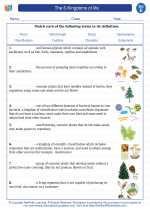The 6-Kingdoms of life -> sedimentation
Sedimentation
Sedimentation is the process by which particles settle out of a fluid (gas or liquid) and come to rest on a surface. This process plays a significant role in the formation of various types of rocks, the shaping of landscapes, and the deposition of soil and minerals.
Types of Sedimentation
There are three main types of sedimentation:
- Chemical Sedimentation: This occurs when dissolved minerals in water form solid deposits. Examples include the formation of limestone and salt deposits.
- Biological Sedimentation: This is the process by which organic materials such as shells, coral, and plant remains accumulate and form sedimentary layers.
- Mechanical Sedimentation: Mechanical sedimentation happens when particles carried by water or wind settle due to a decrease in velocity. This includes the formation of sand dunes and river delta deposits.
Factors Affecting Sedimentation
Several factors influence the process of sedimentation:
- Particle Size: Larger particles settle more quickly than smaller particles.
- Fluid Velocity: Higher fluid velocity keeps particles in suspension, while lower velocity allows them to settle.
- Particle Density: More dense particles settle faster than less dense ones.
- Temperature: Warmer temperatures can decrease the viscosity of a fluid, affecting the settling rate.
Importance of Sedimentation
Sedimentation plays a crucial role in various natural processes, including the formation of sedimentary rocks, the creation of fertile soil, and the shaping of landscapes through the deposition of sediments. It also has practical applications in water treatment, where sedimentation is used to remove suspended particles from water, making it suitable for consumption.
Study Guide for Sedimentation
Here are some key points to remember when studying sedimentation:
- Understand the three main types of sedimentation: chemical, biological, and mechanical.
- Be able to explain the factors that affect the process of sedimentation, including particle size, fluid velocity, particle density, and temperature.
- Recognize the importance of sedimentation in natural processes and human activities, such as water treatment.
- Explore real-life examples of sedimentation, such as the formation of sedimentary rocks and the deposition of soil in river deltas.
By understanding the principles of sedimentation, you can gain insight into the dynamic processes that shape the Earth's surface and contribute to the formation of valuable resources.
.◂Science Worksheets and Study Guides Fifth Grade. The 6-Kingdoms of life

 Activity Lesson
Activity Lesson
 Worksheet/Answer key
Worksheet/Answer key
 Worksheet/Answer key
Worksheet/Answer key
 Worksheet/Answer key
Worksheet/Answer key
 Worksheet/Answer key
Worksheet/Answer key
 Vocabulary/Answer key
Vocabulary/Answer key
 Vocabulary/Answer key
Vocabulary/Answer key
 Vocabulary/Answer key
Vocabulary/Answer key
 Vocabulary/Answer key
Vocabulary/Answer key
